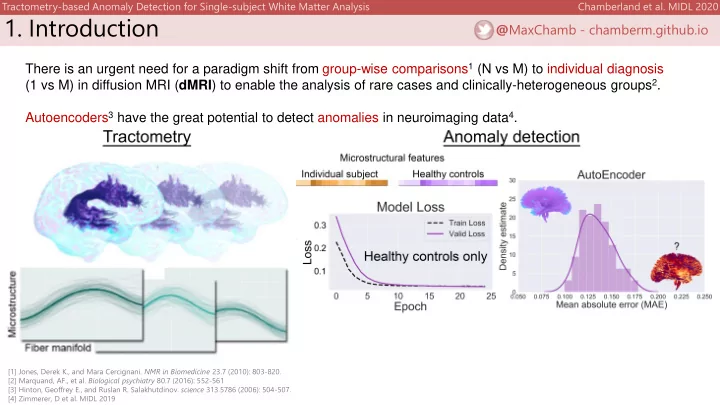

Tractometry-based Anomaly Detection for Single-subject White Matter Analysis Chamberland et al. MIDL 2020 1. Introduction @ MaxChamb - chamberm.github.io There is an urgent need for a paradigm shift from group-wise comparisons 1 (N vs M) to individual diagnosis (1 vs M) in diffusion MRI ( dMRI ) to enable the analysis of rare cases and clinically-heterogeneous groups 2 . Autoencoders 3 have the great potential to detect anomalies in neuroimaging data 4 . [1] Jones, Derek K., and Mara Cercignani. NMR in Biomedicine 23.7 (2010): 803-820. [2] Marquand, AF., et al. Biological psychiatry 80.7 (2016): 552-561 [3] Hinton, Geoffrey E., and Ruslan R. Salakhutdinov. science 313.5786 (2006): 504-507. [4] Zimmerer, D et al. MIDL 2019
Tractometry-based Anomaly Detection for Single-subject White Matter Analysis Chamberland et al. MIDL 2020 2.1 Methods @ MaxChamb - chamberm.github.io Dataset 90 typically developing children ( TD , 8-18 years) 8 children with copy-number variants ( CNV , 8-15 years) Preprocessed 5 as in Chamberland et al. 2019 2 × 2 × 2 mm³ isotropic voxels and 30 diffusion directions at b = 500 s/mm², 30 … at b = 1200 s/mm², 60 … at b = 2400 s/mm², 60 … at b = 4000 s/mm², 60 … at b = 6000 s/mm² (Siemens 3T Connectom scanner @300 mT/m ) Tractometry • Automated tract segmentation using TractSeg 6 Tractometry 7-9 using FA , MD , RISH0 and RISH2 10 • 𝑦 ො x • Tract profiles → feature vector • n = 26 tracts × 20 locations = 520 features for each subject. Minimize [5] Chamberland, M, et al. NeuroImage 200 (2019): 89-100. [6] Wasserthal, J, et al. NeuroImage 183 (2018): 239-253. [7] Bells, S. et al. In Proc ISMRM 2011. [8] Cousineau, M. et al. NeuroImage: Clinical 16 (2017): 222-233. [9] Yeatman, JD., et al. PloS one 7.11 (2012). [10] Mirzaalian, H. et al. NeuroImage 135 (2016): 311-323.
Tractometry-based Anomaly Detection for Single-subject White Matter Analysis Chamberland et al. MIDL 2020 2.2 Methods @ MaxChamb - chamberm.github.io Evaluation • Validation set (n = 16) → CNV (n = 8) + a random subset of TD (n = 8). • The rest of the TD (n = 82) data was used to establish a normative distribution. • Anomaly score → mean absolute error ( MAE ) over all features. • CV shuffle repeat 100 times → derive a mean anomaly score per subject. Using the subject labels, we report the mean ROC area under the curve ( AUC ) across the iterations and compared the results with traditional Z-score 9 and PCA 11 approaches. Z vs M vs MAE Univariate Autoencoder + PCA + Z-score Mahalanobis Distance Mean Absolute Error [9] Yeatman, JD., et al. PloS one 7.11 (2012). [11] Taylor, PN, et al. Neurology (2020).
Tractometry-based Anomaly Detection for Single-subject White Matter Analysis Chamberland et al. MIDL 2020 3. Results @ MaxChamb - chamberm.github.io For all four microstructural metrics, the autoencoder Anomalies mostly occurred along the ILF and OR approach was better at identifying CNV subjects as bundles (bilateral). outliers, providing substantially higher sensitivity- specificity trade-offs.
Tractometry-based Anomaly Detection for Single-subject White Matter Analysis Chamberland et al. MIDL 2020 4. Feature inspection @ MaxChamb - chamberm.github.io Peer-reviewed short paper (@MIDL2020): A key advantage of using deep autoencoders for anomaly detection over traditional PCA-derived arxiv.org/abs/2005.11082 approach is their unique ability to interpret anomaly scores based on feature inspection.
Recommend
More recommend